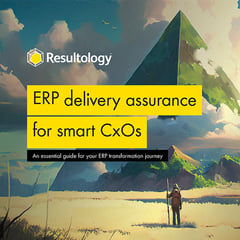When people are choosing a new ERP system, or thinking about upgrading an existing ERP system, often they will create a business case that shows how the new ERP system is more efficient, and will save the business money in the long term.
However, seeing those benefits realised isn't always as straight forward as you think.
Without the right vendors, delivery partners and well defined business requirements, you might find you new ERP doesn't live up to it's cost saving expectations.
To get the right outcomes, you need to get the spec and select process right from the off.
Here are 10 things to look out for during your ERP Spec and Select process to make sure you choose the right software and delivery partners that will save your business money.
1. Understand your Business Processes for a better ERP Spec and Select process
Your ERP system should support your business processes. If you don’t know what these are, you are going to struggle to know whether a solution is suitable. You need to think about the processes you use today and those you may need in the future to support your business strategy.
As an example, in moving from an organisation that is focussed on R&D to Production, the requirements in areas such as the fulfilment of Customer Orders and Payroll are likely to change considerably and you will need some flexibility.
If you enter into a selection process without a clear understanding of your business processes, you will be assessing the solution features available ‘out of the box’. The sales dynamic will be around what the vendor solution can provide, rather than what you need. By investing some effort into cataloguing your business processes, you can flip this to a conversation about how the solution will address your requirement.
At Resulting, we recommend building a Business Process Framework, written in ‘business language’ rather than ‘IT speak’ to validate the scope with the business. This is then central to the requirements provided to prospective vendors. Vendors can be asked to confirm whether their solution would support each in-scope business process, and the degree to which customisation would be necessary to achieve this.
2. Identify the things you want most from your New ERP system
While it is important to understand all your business processes, it's also important to understand that they're not all equal. Some will be more critical to business operations than others, some may be used only infrequently and some may have workarounds.
You can use the MoSCoW technique to rank and prioritise business processes as requirements. This will include Must Haves, Should Haves, Could Haves and Won't Have Yets. These can be captured for your backlog for the future.
Understanding the priorities is another way that you can ensure which solution will best meet your organisation's needs. It is also a tool that can be used beyond the selection process to help ensure items are prioritised during the implementation.
3. Don’t forget Non-Functional and other Specific Requirements of your ERP
Alongside functional requirements, you need to consider non-functional requirements. A solution will fail if it falls short in areas such as security, reliability and usability.
There may also be additional requirements that fall somewhere between functional and non-functional - legal, regulatory or financial that may be specific to your company or industry sector. Don’t assume that a potential vendor will be aware of these or understand how to apply them to your business. In the same way, as you need to catalogue your business processes, you will need to document these requirements in a way that allows the vendor to incorporate them into their solution.
If you have very specific requirements, look for a solution that can meet these and a partner who has relevant experience and a track record of successful implementations at other companies in the industry. Some solutions may need to incorporate a third-party add-on to meet specific requirements in areas such as quality assurance, reporting or labelling. Again, check that your partner has experience with these.
4. Watch out for vague language when discussing ERP requirements
One of the biggest risks to the timescale and budget on an ERP implementation is a set of vague or missing requirements. By clearly documenting your functional, non-functional and any other specific requirements, you are giving your vendor a fighting chance of building a solution that will meet your needs. Any grey areas can be fleshed out through clarification questions or working sessions.
Some vendors may choose to leave a requirement vague and propose that this is reviewed during design. Watch out for phrases such as ‘The scope is subject to confirmation during the Design phase" or even "etc." in proposals. This may be well-intentioned and provide a window in which to refine the requirements of the solution to ensure that it meets needs of the business more closely but in combination with a time and materials based commercial model, this will usually result in expectations not being managed and a risk to the implementation costs and schedule.
5. Choose an ERP vendor that's a good fit for your business
The implementation of an ERP system is going to be a significant effort for the business, taking place over several months, during which you will be working with a new partner and a new set of people. To be successful, you need to be comfortable with the way they work, trust them completely, have confidence in the way they work and that they have the best interests of your organisation in mind.
Vendor fit should be considered as part of the selection process, and while it may be difficult to quantify there are a few ways to do this.
You can request testimonials and details of reference sites from satisfied customers of a similar size and a similar industry. These will be able to give you an independent view of what it is like to work with the vendor, though you need to remember that a vendor is unlikely to provide details of someone who will give negative feedback.
As a team, you can also have this aspect in mind during any demonstrations or workshops. When you are meeting the vendors try and consider whether you can see you and your colleagues working well with this partner, whether you have full confidence that they will deliver this project, and whether you trust them to be the type of partner who will be open with you about issues, risks and options available. You should discuss this with your colleagues. You will usually find that people have a fairly similar view and form it fairly early.
6. Be a good customer to your ERP vendor
A good partnership needs a good customer. This can mean many things but openness, transparency and communication all help to give your prospective supplier a fighting chance of being a good partner.
Being as thorough and detailed as you can be with requirements will help to ensure that they are considered in the solution. If items are not detailed, the supplier is unlikely to assume that they are required and may choose to leave them out or downplay them in their proposal. Effective two-way communication is the best way to ensure both sides understand each other and that expectations are met.
You should also keep suppliers informed of the status of a selection process. If they are not kept informed, they may assume that you are not interested and this will have an impact on the relationship. A supplier will invest a lot of time and effort in building a proposal and deserves some time and effort back around communication and feedback.
7. Get key stakeholders ‘on board’ with the Spec and Select Process
A successful implementation will be dependent upon the business embracing the change it brings. Change is difficult, it can make people feel anxious and there is a natural tendency to resist it within an organisation.
Key business stakeholders need to understand the reason for the change and feel part of it. Most people will want what is best for their organisation and their customers but may resist the change anyway because they don't understand it, don't agree with it, don’t feel involved in it, feel it is being imposed or are worried about the impact it may have on them personally. If these issues are not addressed it can create a destructive dynamic within a company that will require effort to manage and can threaten the success of the implementation.
In our case study, we looked to involve key stakeholders during the selection process and this will continue through the implementation. We held a kick-off meeting at the beginning of the process, we asked representatives from each function to help define the scope and priorities, we have held workshops to understand specific areas such as project management and manufacturing within the organisation, and invited those same representatives to product demonstrations and workshops to make sure everyone has the opportunity to see the solutions and meet the vendors.
At some point, it will be necessary to make the selection and while it may not be possible to please everybody, involving them and being transparent in communications will help to make sure the process and rationale are understood. If managed well, those people involved in the selection can become its biggest advocates and your solution ‘champions’.
8. Understand the total cost of ownership of ERP
The total cost of ownership is made up of many components including implementation, license, hosting and support charges.
Within these, there can be differences based on the commercial arrangement e.g. perpetual vs subscription licenses, or assumptions made to allow hosting costs to be estimated. Some costs will also be incurred once and some will repeat periodically. All these moving parts can make the overall cost difficult to understand but this is necessary to make meaningful comparisons between opinions and to estimate the true cost to your business.
You should ask prospective suppliers to present their costs in a standard format, with all costs itemised to enable you to understand how they are built up. For example, software license costs should include the type of license, the number of users, the period covered and the rate. Understanding the drivers will help you to understand the detail behind the differences and how you can take advantage. They will also help you get a clear understanding of the initial costs of a solution, the likely costs in the future and enable you to make accurate comparisons between solutions.
You may also look at being proactive on pricing. If you have a price bracket, let the supplier know. This will help to avoid any misunderstandings, posturing and negotiation. If you have a Ford Focus budget and are contacting Ferrari about a car, you are unlikely to get something in your price range.
In a real-life situation, we saw an offshore solution would cost significantly less to implement than a solution based in the UK. The main driver for this was the lower labour rate in the offshore solution. The counter to this was that the provider was not able to offer preferential rates on software licenses which negated some of the initial saving and had the potential to reduce the saving as each annual license fee was paid.
9. Challenge Assumptions around ERP
In our experience, assumptions can be made during Spec and Select that may influence the selection process in a negative way and reduce the options available to you, or influence the final decision that is made.
For example, imagine several key stakeholders were assumed to have a strong preference for a certain solution due to past experiences. Because of this they miss demonstrations and workshops with other suppliers. This assumption will have an impact on the selection process as choosing a different option could be seen to introduce a risk to the adoption of the new system, and a personal risk to those advocating it.
To ensure that all options are considered equally, those leading the selection process must validate assumptions by speaking to the stakeholders about them. This can help negate the impact of assumptions and make sure all options are properly considered.
10. Understand the impact of ERP implementation on your business
As stated earlier, an ERP implementation is a significant effort for any business. Organisations look for partners to help them with this but a partner cannot and should not do everything.
You should read and understand the partner's proposal and implementation plan carefully. Look at the definition of key roles and responsibilities and plot them against an outline organisation structure to understand what roles the vendor is assuming you will fill. Typical areas that remain the responsibility of the customer include change management, training, data migration, systems administration - but there will be others and you will need to make sure you are ready when they are needed.
You will need to consider whether you have the capability and capacity within your existing team.
If the answer is no, will you ask the vendor to take them on or will you need to recruit permanent or contract resources? Remember that if you use your existing team, you may also need to consider backfilling them if it takes them away from their usual duties.
You should also remember that the implementation is just the beginning of the journey. Your business and your business operating model will need to change. A new ERP system is going to introduce processes and activities that didn't exist before.
The new system will need to be supported and maintained, system data will need to be maintained, new employees will need training on the system, new releases maintained.
We would recommend that organisations start to consider the impact of the implementation on their future business operating model early to give them time to get themselves ready.
Over the past 20 years, we've worked with dozens of businesses to define, build, and establish the capabilities they require to run and improve their ERP application to support their business strategy and improve business performance.
Our consulting work has led to the development of a comprehensive Future Operating Model maturity assessment framework that we can use to run a short, sharp engagement to help our customers understand areas where they will need to adapt their business operations.
To find out how we run ERP spec and select, contact us here.












